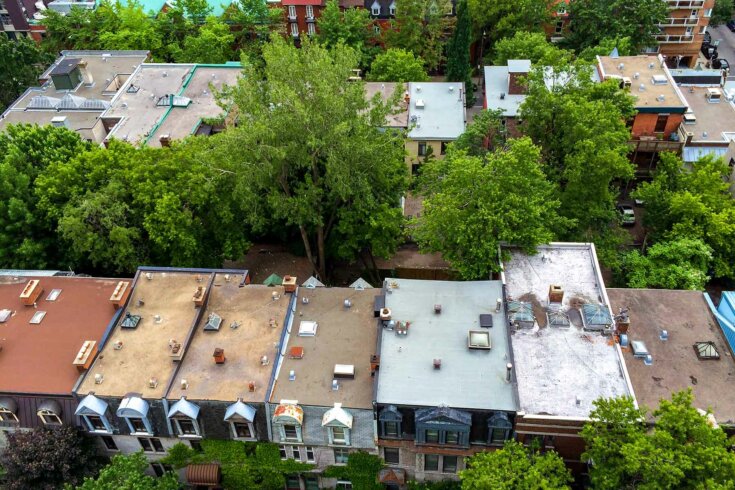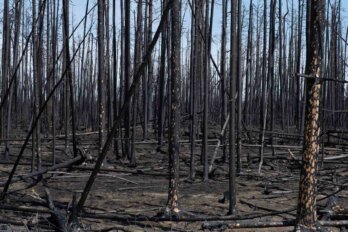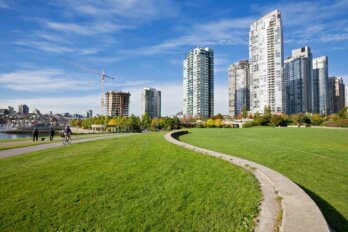Vancouver is planning to raise its tree canopy coverage to 30 percent by 2050. Toronto has set a goal of 40 percent by 2050. In 2023, Montreal committed $76 million toward raising the canopy coverage to 26 percent by next year. Winnipeg’s One Million Tree Challenge calls on residents to help plant a million new trees over the next twenty years.
In the face of record-breaking heat waves and storms, it makes sense to plant more trees—they help cool the environment, capture carbon, and absorb rainfall, among other benefits. But many cities aren’t planting a sufficient number to keep pace with deforestation and development, says Michael Petryk, arborist and director of urban programs for Tree Canada. Perhaps more concerning is that most aren’t doing enough to care for and preserve the ones they already have, especially in the face of climate change.
Protecting veteran trees—those grown large enough to provide substantial canopies—is just as important as planting new ones when it comes to mitigating the effects of climate change, says Petryk—if not more so. In many cities, newly planted trees are often left to fend for themselves. Without proper care and maintenance, they die before reaching maturation. Most cities and municipalities have some kind of ordinance that protects trees on their lands from being cut down, Petryk says. But those ordinances are often overruled in favour of development projects.
Anecdotally, Petryk says, many cities are reducing rather than increasing their canopy cover. “Sure, a city could say you have to plant ten new trees for every mature tree you cut down,” he says. But, after cutting down three mature trees, for example, the new trees’ canopies wouldn’t match those of the old ones for another decade—“if we’re lucky.” And because trees are considered easily replaceable, he says, we often don’t see their true value.
Morden, Manitoba, is a standout. One of its greatest sources of pride, after its annual corn and apple festival, is its lush green tree canopy cover. Much of it came up in recent decades. In the ’90s, a residents’ committee pitched to a willing city council a five-year program to plant more trees. The goal at the time was to turn the prairie city into an example for other Manitoba municipalities.
In 2017, Shawn Dias, Morden’s director of parks and urban forestry, led a project to catalogue and analyze all trees on municipal properties, assigning a concrete dollar value to each one and describing the benefits they provided. His goal, he told me over Zoom, was to demonstrate to city council that “what we have here is not just nice to look at.” Trees, he says, are “assets within the city—no different than a fire hydrant or a sidewalk or a water main or a sewer.” Except that, unlike most built infrastructure, trees offer more value as they age. And to get the most out of them, cities need to invest more in their upkeep.
His assessment found that Morden’s 5,330 urban trees had a combined value of nearly $7.5 million and saved the community more than $600,000 a year by improving air quality, raising property values, and lowering energy consumption cuts—for example, by offering shade and reducing the need to cool indoor spaces. Armed with these figures, which he describes as a conservative undervaluation, Dias convinced councillors to approve new tree protection policies against threats such as construction work and invasive species.
Ever since, his department has been shielded from budget cuts and has had a bigger voice at the city planning table. Under Dias’s direction, the city has increased the diversity of its tree species through replacements and new plantings. This has helped buffer the ecosystem against pests, built resilience to climate change, and increased wildlife habitat. To prevent the spread of Dutch elm disease, a notorious tree killer, the city instituted regular pruning and anti-fungal injections, which reduced the number of infected trees the city had to cut down from 150 to about forty-five annually. Thanks to these measures, says Dias, the overall health of the city’s trees has improved over the past few years.
Not every city, especially small municipalities without the resources to track their tree canopies, can replicate what Morden has done. Larger cities often face excessive bureaucracy, higher expenses, and other, seemingly more pressing, priorities. It may be hard to argue for protecting trees in the face of a mounting housing crisis, for example. Development projects in many cities can come at the expense of green spaces, and cities may lack adequate policies to force developers to protect trees on lots and safeguard undeveloped land from being bulldozed. But, in racing to build new housing in the name of affordability, leaving trees as an afterthought in the planning process, cities often exacerbate the inequitable distribution of greenery.
A 2022 Nature Canada report, which mapped out the urban tree cover in Vancouver, Abbotsford, Calgary, Toronto, and Montreal, identified flaws in Canada’s urban tree planning that disadvantage racialized and lower-income communities. The report argued that city-wide canopy coverage targets do not address equity of access for different communities and neighbourhoods. A better approach, according to the report, is a ratio known as the 3-30-300 rule: that “everyone should be able to see at least three trees from their home, that all neighbourhoods should have at least a 30% tree canopy, and that all residents should have a greenspace of at least one hectare within 300 metres of where they live.”
Increasing canopy coverage is not only a matter of planting more trees; it’s also about planting the right ones. Take the Norway maple—a non-native, invasive species that dominates the tree canopy cover in some areas, particularly in Ontario. Native to Europe and western Asia and known for its rapid growth potential, the Norway maple was planted widely across Canada after the Second World War, following the loss of white elms in urban spaces to Dutch elm disease. It’s often chosen for its appearance, ability to withstand urban conditions, low maintenance requirements, and relatively low cost. But the Norway maple’s roots secrete toxins that are harmful to fungi that other trees rely on, causing injury to the surrounding ecosystem. It also has many competitive advantages over native species and, when it spreads to natural habitats and urban areas, has the potential to replace native tree species altogether, decreasing species diversity, and suppressing native tree regeneration. A recent report described it as “a serious threat to woodlands across Ontario.” Still, Petryk says, tearing down every Norway maple would not be a valuable use of what little resources exist for tree maintenance and protection.
Isabelle Aubin, a research scientist in forest ecology at Natural Resources Canada, helped develop PlantR, an online planning tool that recommends tree species combinations to meet certain environmental goals, such as soil restoration or resistance to invasive species. Melissa Spearing, one of Aubin’s colleagues and a biologist at the National Tree Seed Centre, in Fredericton, says the right mix of trees could, in some cases, become self-sustaining: the natural processes that regenerate forests would come into play, reducing the need for human intervention. And that longevity would bring added value. People are often shocked when she tells them that only one in a million oak tree seeds will grow to become a tree the same size as the one it came from; to put it into perspective, that’s one seed out of two or three dump trucks’ worth. A hundred newly planted trees, she says, do not have the same value as one large, old one.
The true value of a tree cannot be quantified properly in dollars, says Lynn Rosales, who works with the Aamjiwnaang First Nation’s environmental department. When advocates make the case for investing more in trees, she says, they tend to focus on the money. “What is missing” in such conversations, she says, “is the spiritual connection.” In an ideal world, a broader recognition that all living beings are interconnected would leave us no choice but to care for trees.
Dias says Morden’s heightened standards for urban forest management have fostered a culture of appreciation among its residents. In a 2022 survey, over 90 percent of respondents said they felt some kind of connection to the trees in the community.
Often, that dedication manifests in everyday decisions. Recently, Dias’s tree inventory and analysis allowed the urban forestry management team to convince a developer behind a planned apartment building to stay away from five large elm trees, each between ninety and ninety-five years old, that were adjacent to the lot. According to the developer’s plans, the property line would have fallen right on the trees’ structural and feeder root systems. Once Dias explained the significance of the elms’ cathedral canopy along the town’s main thoroughfare, the developer worked with him to change the construction plans.
“We actually got him to set the building back farther,” he says. “The developer didn’t want to be responsible for the demise of five significant boulevard trees.”





